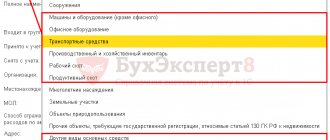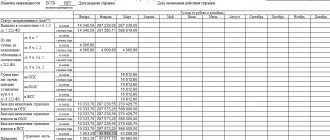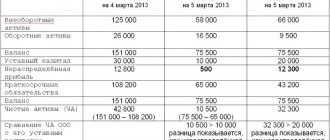The organization has the right to transfer to the counterparty a bill of exchange of a third party in payment of its debt. Such a transfer means the repayment of obligations (part of the obligations) of the organization to the counterparty.
This follows from articles 407 and 409 of the Civil Code of the Russian Federation.
Attention: settlements using bills of exchange (including third parties) increase the risk of conducting an on-site tax audit for all participants in the bill of exchange transaction (clause 12 of Appendix 2 to the order of the Federal Tax Service of Russia dated May 30, 2007 No. MM-3-06/333 ).
Accounting
Interest (discount) bill
In accounting, reflect the transfer of an interest-bearing (discount) bill of exchange from a third party to a counterparty in payment for goods (work, services) as a disposal of financial investments (clause 25 of PBU 19/02). That is, in correspondence with account 58 “Financial investments” sub-account “Debt securities” (58-2) (Instructions for the chart of accounts).
As part of other income, recognize the value of the transferred bill of exchange, which is equal to the entire amount of the debt repaid by it (clauses 7 and 10.1 of PBU 9/99). And the expenses include the cost of the bill reflected in account 58-2, and interest accrued until the bill is disposed of (clause 11 of PBU 10/99). Make the following entries:
Debit 60 (76) Credit 91-1 – a bill of exchange of a third party was transferred in payment for goods (work, services);
Debit 91-2 Credit 58-2 – the value of a third party’s bill of exchange is written off, at which it is recorded at the time of its transfer;
Debit 91-2 Credit 76 subaccount “Interest on bills received” - accrued but uncollected interest on a third party bill is written off.
This scheme of accounting entries follows from the Instructions for the chart of accounts (accounts 58, 91).
Interest-free (discount-free) bill
The transfer of an interest-free (non-discount) bill of exchange of a third party to a counterparty in payment for goods (work, services) should be reflected in the debit of account 91 “Other income and expenses” in the subaccount “Other expenses” (91-2) in correspondence with account 76. That is, the account on which the transferred security is accounted for.
Make an entry in accounting:
Debit 91-2 Credit 76 subaccount “Settlements on bills received” - reflects the transfer of a bill in payment for goods (work, services).
This follows from the Instructions for the chart of accounts (accounts 76 and 91) and paragraphs 11 and 17 of PBU 10/99.
Reflect the disposal of the bill at the value at which it was recorded on the date of transfer.
Documenting
Confirm the fact of transfer of the bill and the date of the transaction with a primary document drawn up in any form; a unified form is not provided. For example, this may be an act of acceptance and transfer of bills of exchange from third parties, containing all the required details in accordance with paragraph 2 of Article 9 of the Law of December 6, 2011 No. 402-FZ. At the same time, it is necessary to issue an endorsement on the transfer of all rights under the bill (clause 3 of Article 143, clause 3 and subclause 2 of clause 8 of Article 146 of the Civil Code of the Russian Federation).
Situation: is the transfer of a third party’s bill of exchange to a counterparty in payment for purchased goods (works, services) for tax purposes?
Yes it is.
For tax purposes, the transfer of a bill of exchange in payment for goods (work, services) leads to two transactions:
- for the acquisition of goods (works, services);
- for the sale of securities.
This follows from the provisions of Article 128, paragraph 2 of Article 142 of the Civil Code of the Russian Federation, paragraphs 2, 3 of Article 38, paragraph 1 of Article 39 of the Tax Code of the Russian Federation and is explained by letters of the Ministry of Finance of Russia dated October 10, 2006 No. 03-11-04/2/202 , dated June 6, 2005 No. 03-04-11/126, dated November 24, 2004 No. 03-03-01-04/1/141, Ministry of Taxes of Russia dated June 15, 2004 No. 03-2-06/ 1/1372/22.
In arbitration practice there are examples of court decisions that recognize the legitimacy of such a conclusion (see, for example, the decision of the Supreme Arbitration Court of the Russian Federation dated May 18, 2007 No. 5697/07, the resolution of the FAS Volga District dated January 26, 2007 No. A57-16025/05 -33).
Advice: there are arguments that allow an organization that pays a counterparty with a third party bill of exchange not to recognize its transfer as an operation to sell a security. They are as follows.
Depending on the purpose of the transfer, the bill of exchange can be used as:
- method of drawing up a loan agreement;
- securities as a way to generate additional income;
- means of settlements with counterparties.
This follows from Article 5, paragraph 2 of Article 142, Article 815, paragraph 1 of Article 408, Article 862 of the Civil Code of the Russian Federation, the Regulations approved by the resolution of the Central Executive Committee of the USSR and the Council of People's Commissars of the USSR dated August 7, 1937 No. 104/1341, and the ruling of the Constitutional Court of the Russian Federation dated April 4, 2006 No. 98-O.
As a rule, when transferring a bill of exchange in payment for goods (work, services), the bill itself is not the object of the transaction, but a means of settlement with counterparties (a means of payment). The transfer of a bill of exchange as payment is equivalent to the transfer of funds. That is, the bill in this case is not a commodity in the sense of paragraph 3 of Article 38 and paragraph 1 of Article 39 of the Tax Code of the Russian Federation. This means that its sale does not occur when repaying the debt to the counterparty. This point of view is confirmed by arbitration practice (see, for example, the rulings of the Supreme Arbitration Court of the Russian Federation dated August 11, 2009 No. VAS-10058/09, dated February 8, 2008 No. 910/08, dated February 4, 2008 No. 403/08, dated August 29, 2007 No. 10480/07, dated April 20, 2007 No. 4773/07, resolution of the Federal Antimonopoly Service of the Moscow District dated March 11, 2009 No. KA-A40/1255-09, dated December 11, 2007 No. KA- A40/12645-07-2, West Siberian District dated May 7, 2007 No. F04-2543/2007(33746-A27-40), Volga District dated October 23, 2007 No. A57-13898/2006, Ural District dated September 24, 2008 No. Ф09-6808/08-С3, dated October 1, 2007 No. Ф09-7982/07-С3, dated February 8, 2007 No. Ф09-363/07-С3 and dated January 16, 2007 No. Ф09-11811/06-С3, Volga-Vyatka District dated June 22, 2006 No. A31-2731/2005-13).
"If there is darkness, there must be light..."
In some cases, tax authorities’ claims to transactions involving bills of exchange are quite justified. Moreover, even taxpayers themselves cannot always explain the use of this financial instrument by the presence of an independent business purpose and economic feasibility. As a rule, this occurs in tax disputes where there is a sale of questionable bills of exchange or participation in transactions of liquidated legal entities.
But the assertion that the use of bills of exchange is always aimed only at tax evasion, and therefore, conscientious taxpayers should forget about this financial instrument, is unfair. After all, in the end, with its help, companies can solve a lot of current short-term problems, such as investing free funds, when a bill of exchange acts as an independent subject of purchase and sale, as well as attracting borrowed funds. It can also act as a means of payment.
Currently, many organizations, due to the current economic situation, are experiencing a sharp shortage of working capital. Of course, no one forbids applying for a loan from a bank, but... Credit organizations are now “feeling” not in the best way, and therefore they are putting forward quite strict requirements for applicants for borrowed funds. At a minimum, they will have to provide adequate security for the loan, as well as involve guarantors in this matter, naturally, revealing almost all of their ins and outs to the credit institution. However, this problem can be solved by issuing your own bills.
Sergey Danilov
, for the magazine “Moscow Accountant”
What will it be like?
It is very difficult to avoid collisions with the law. What will you face if the scales in a conflict with the state tip against you? The mobile application will answer this question. Find out more >>
BASIC
The transfer of a third party's bill of exchange in payment for goods (work, services) leads to the emergence of two transactions for tax purposes (for the acquisition of goods (work, services) and for the sale of a security).
Purchased goods (work, services) paid for by a third party bill of exchange must be taken into account when calculating income tax, depending on:
- on the tax accounting rules that apply to the corresponding type of expenses;
- on the method that the organization uses when calculating income tax (accrual method or cash method).
At the same time, with the cash method of calculating income tax, goods (work, services), in payment for which the organization transferred a bill of exchange to a third party, are considered paid at the time of its transfer.
This follows from articles 252, 272 and 273 of the Tax Code of the Russian Federation.
In addition, it is necessary to generate a financial result from the sale of a security (Article 280 of the Tax Code of the Russian Federation, letters of the Ministry of Finance of Russia dated March 21, 2011 No. 03-02-07/1-79, dated November 24, 2004 No. 03-03-01 -04/1/141). It is determined according to the rules of Article 280 of the Tax Code of the Russian Federation.
Transactions on the sale of securities are not subject to VAT. Therefore, the transfer of a bill of exchange in payment for goods (work, services) is also not subject to taxation. This follows from subparagraph 12 of paragraph 2 of Article 149 of the Tax Code of the Russian Federation and is confirmed by letter of the Ministry of Finance of Russia dated March 21, 2011 No. 03-02-07/1-79. For more information about this, see How to pay VAT when paying by bill of exchange.
In this case, input VAT on goods (works, services) paid by bill of exchange can be deducted in the general manner - after the goods are accepted for registration, if there is an invoice and other necessary conditions are met (clause 2 of Article 171, clause 1 of Art. 172 of the Tax Code of the Russian Federation). For more information about this, see How to pay VAT when paying by bill of exchange.
An example of reflection in accounting and taxation of transactions for the acquisition of goods paid for by a bill of exchange of a third party. The market value of this bill is not determined. The organization applies a general taxation system
On April 1, CJSC Alfa acquired a promissory note with a face value of 300,000 rubles.
On August 16, Alpha paid the supplier Torgovaya LLC for goods purchased from him worth 354,000 rubles. (including VAT – RUB 54,000) by a third party’s bill of exchange. The interest rate on the bill is 10 percent per annum.
The value of the bill on the date of its transfer was recognized by the parties as equal to the value of the goods, including VAT.
The cost of the bill in accounting and tax accounting on the date of its transfer was 300,000 rubles. The amount of interest accrued by Alfa at the time of transfer of the bill and previously taken into account for taxation is equal to 11,260 rubles. (RUB 300,000 × 10%: 365 days × 137 days).
Alpha's accounting policy for tax purposes provides for determining the settlement price for debt securities based on their nominal value and profitability conditions.
The actual price of the bill (RUB 354,000) at the time of transfer to Hermes does not deviate from the estimated price by more than 20 percent.
To account for interest accrued on a bill of exchange, the accountant opened a subaccount for account 76 “Interest on bills received.”
On August 16, the following entries were made in Alpha’s accounting records:
Debit 41 Credit 60 – 300,000 rub. (RUB 354,000 – RUB 54,000) – purchased goods are capitalized;
Debit 19 Credit 60 – 54,000 rub. – input VAT on purchased goods is taken into account;
Debit 68 subaccount “Calculations for VAT” Credit 19 – 54,000 rubles. – accepted for deduction of VAT on purchased goods;
Debit 60 Credit 91-1 – 354,000 rubles. – a third party’s bill of exchange has been transferred in payment for goods;
Debit 76 subaccount “Interest on bills received” Credit 91-1 – 1315 rubles. (RUB 300,000 × 10%: 365 days × 16 days) – interest accrued on a third party’s bill for August;
Debit 91-2 Credit 58-2 – RUB 300,000. – the value of a third party’s bill of exchange, at which it was recorded at the time of its transfer, has been written off;
Debit 91-2 Credit 76 subaccount “Interest on bills received” – 11,260 rubles. – accrued but uncollected interest on a third party’s bill of exchange for the entire period of its ownership by the organization is written off.
Alpha pays income tax monthly and uses the accrual method.
When calculating income tax for August, Alpha’s accountant included interest in the amount of 1,315 rubles in non-operating income.
The taxable profit on the transfer of a third party's bill of exchange as payment for goods was determined by the Alpha accountant as follows: RUB 354,000. – 300,000 rub. – 11,260 rub. = 42,740 rub.
The amount of debt to the supplier, in payment for which the bill of exchange was transferred (income - 354,000 rubles), the accountant reflected in the income tax return on line 011 of sheet 05.
The cost of the transferred bill of exchange (expense - 300,000 rubles) was reflected by the accountant in the income tax return on line 021 of sheet 05.
The amount of interest previously included in non-operating income (non-operating expense - 11,260 rubles) was reflected by the accountant on line 200 of Appendix No. 2 to sheet 02 of the income tax return.
The delivery was paid for by a third party bill of exchange. We calculate VAT
Financiers explained that the transfer of a third party's bill of exchange in exchange for goods is recognized as the sale of a security, and such a transaction is not subject to value added tax.
There are other nuances that you should be aware of... The company transfers the bill of exchange
So, the trading company has received goods from the supplier. And in payment she handed over a bill of exchange from a third party. In the case under consideration, two operations take place: – for the acquisition of goods; – on the sale of securities. Transactions on the sale of securities are not subject to value added tax. Therefore, the transfer of a third party's bill of exchange in payment for goods is also not subject to taxation. This follows from subparagraph 12 of paragraph 2 of Article 149 of the Tax Code of the Russian Federation and is confirmed by letter of the Ministry of Finance of Russia dated March 21, 2011 No. 03-02-07/1-79. Thus, if a company sells goods whose sales are subject to tax, there will be transactions that are subject to tax and that are not subject to tax (sale of goods and sale of a security). Therefore, the company will have to organize separate accounting of such transactions. But there are arguments that make it possible not to recognize the transfer of a third party’s bill of exchange as an operation for the sale of a security (and, accordingly, not to maintain separate accounting). They are as follows. As a rule, when transferring a bill of exchange as payment for goods, the security itself is not the object of the transaction, but a means of settlement with the counterparty (means of payment). The transfer of a bill of exchange as payment is equivalent to the transfer of funds. That is, the bill in this case is not a product from the point of view of the Tax Code of the Russian Federation. This means that it is not sold when repaying the debt to the supplier. This position is confirmed by arbitration practice (see, for example, the rulings of the Supreme Arbitration Court of the Russian Federation dated August 11, 2009 No. VAS-10058/09, dated February 8, 2008 No. 910/08). However, having abandoned separate accounting in this situation, the company must be prepared for tax disputes. After all, most likely, controllers will recognize the lack of such accounting as unlawful. “Input” VAT on goods paid for by bill of exchange can be deducted in the general manner: after the receipt of valuables, if there is a correctly executed invoice from the supplier and other necessary conditions are met. Example 1.
The retail chain CJSC Materik acquired an interest-free promissory note from Sberbank of Russia with a nominal value of 300,000 rubles.
In June 2011, the company received goods worth RUB 354,000 from a supplier. (including VAT - 54,000 rubles) and paid for them with a bill of exchange. The value of the bill on the date of its transfer was recognized by the parties as equal to the full amount of the retail chain's receivables to the counterparty (that is, the cost of the goods including VAT). The accountant of JSC Materik made the following entries: DEBIT 41 CREDIT 60
- 300,000 rubles.
(354,000 – 54,000) – purchased goods are capitalized; DEBIT 19 CREDIT 60
– 54,000 rub.
– “input” VAT on purchased goods is taken into account; DEBIT 68 subaccount “Calculations for VAT” CREDIT 19
– 54,000 rub.
– accepted for deduction of VAT on purchased goods; DEBIT 60 CREDIT 91 subaccount “Other income”
– 354,000 rubles.
– a third party’s bill of exchange has been transferred in payment for goods; DEBIT 91 subaccount “Other expenses” CREDIT 58
– 300,000 rub.
– the value of a third party’s bill of exchange has been written off. >|In accounting, as part of other income, they reflect the value of the transferred bill, which is equal to the entire amount of the debt repaid by it.
And the expenses include the cost of the bill, reflected on account 58, and interest accrued until the disposal of the bill (if any).|< The company receives the bill
The supplier's accounting records two transactions: – sales of goods; – receipt of a security (third party bill of exchange). In this case, the tax is imposed not only on the proceeds from the sale of goods, but also on the interest (discount) on the bill (if provided).
Moment of determining the tax base
VAT must be charged to the budget either on the day of shipment of goods or on the day of payment, depending on which of these events occurred earlier.
The basis is paragraph 1 of Article 167 of the Tax Code of the Russian Federation. Therefore, if the goods were shipped before receipt of the bill of exchange, value added tax is calculated at the time of sale of the goods. If a third party’s bill of exchange is received before the transfer of goods, then for the purposes of calculating VAT it is considered the receipt of advance payment (advance payment). This means that on the date of acceptance of a third party’s bill of exchange for accounting, an “advance” value added tax should be charged (subclause 2, clause 1, article 167 of the Tax Code of the Russian Federation). The Ministry of Finance of Russia adheres to a similar point of view in its letter dated April 10, 2006 No. 03 - 04 - 08/77. Upon receipt of an advance payment in the form of a third party bill of exchange, the following entries are made: DEBIT 58 CREDIT 62 subaccount “Settlements for advances received”
– a third party bill of exchange was received as an advance payment for goods;
>|The received bill of exchange is accepted for accounting at its original cost.|< DEBIT 76 subaccount “Calculations for VAT from advances received” CREDIT 68 subaccount “Calculations for VAT”
- VAT is charged on the amount of the prepayment received in the form of a bill of exchange from a third party.
At the time of shipment of goods, the tax accrued from the advance payment is deducted in the general manner (clause 8 of Article 171 of the Tax Code of the Russian Federation). At the same time, the following entries are made: DEBIT 90 subaccount “VAT” CREDIT 68 subaccount “Calculations for VAT”
– VAT is charged on proceeds from the sale of goods;
DEBIT 68 subaccount “Calculations for VAT” CREDIT 76 subaccount “Calculations for VAT from advances received”
– previously accrued “advance” VAT is accepted for deduction.
VAT on interest (discount) on a bill
The bill may provide additional income in the form of interest or discount.
Interest on a bill is the amount that, upon repayment of the bill, the supplier company (bill holder) is entitled to receive in addition to its face value. This rule applies if the drawer (the primary owner of the bill, for example a bank) has determined the rate at which interest is calculated on the bill itself. If the interest rate is not specified in the bill, it is considered non-interest bearing. This procedure is established by Articles 5 and 77 of the Regulations, approved by Resolution of the Central Executive Committee of the USSR and the Council of People's Commissars of the USSR dated August 7, 1937 No. 104/1341. In addition, the drawer may provide for the accrual and payment of interest only on a perpetual bill (that is, a bill that is payable at sight or after a certain time after presentation). If the interest condition is specified in a term bill (payment of which is set within a strictly defined period), it is considered invalid. The discount on a bill is the difference between the cost of acquiring (transferring) the bill and its face value. For example, a discount may arise if the face value of a bill is greater than the amount of receivables that the counterparty repaid with this security. If the goods for which the bill of exchange is received are subject to value added tax, the interest (discount) on the bill of exchange increases the tax base. Reason - subparagraph 3 of paragraph 1 of Article 162 of the Tax Code of the Russian Federation. However, the tax must be charged not on the entire amount of interest (discount), but only on that part of it that exceeds the amount of interest calculated at the refinancing rates of the Central Bank of the Russian Federation in force in the periods for which the calculation is made (subclause 3, clause 1, article 162 Tax Code of the Russian Federation). Since interest (discount) is associated with payment for goods, the provisions of paragraph 4 of Article 164 of the Tax Code of the Russian Federation apply in this case. In other words, the tax is calculated at the estimated rate (18/118 or 10/110). That is, if the goods themselves, in payment for which a bill of exchange is provided, are taxed at a reduced rate, a rate of 10/110 is applied to interest (discount). If on a general basis, then the tariff 18/118 is used. But if the values for which they paid with a bill of exchange are not subject to value added tax, then there is no need to calculate tax on the amount of interest (discount) (clause 2 of Article 162 of the Tax Code of the Russian Federation). Please note the following point: VAT on the amount of interest (discount) is accrued on the date of actual receipt of money to repay the bill (and interest on it), and not on the day the security is received or interest is accrued. After all, paragraph 1 of Article 162 of the Tax Code of the Russian Federation provides for the inclusion in the VAT tax base of amounts actually received related to payment for goods sold (letter of the Federal Tax Service of Russia for Moscow dated April 28, 2009 No. 16-15/41799). In this case, the supplier (bill holder) must reflect the amount of interest (discount) in the invoice, which is drawn up in one copy and registered in the sales book. This follows from paragraph 19 of the Rules, approved by Decree of the Government of the Russian Federation of December 2, 2000 No. 914, and paragraph 3 of Article 168 of the Tax Code of the Russian Federation. Example 2.
On June 4, 2011, the wholesaler (supplier) shipped a consignment of goods to the buyer for a total amount of 118,000 rubles.
(including VAT – 18,000 rubles). Cost of goods sold – 90,000 rubles. On the same day, in payment for the goods, the buyer issued the wholesale company a promissory note from a third party (Razvitie Bank) with a nominal value of 130,000 rubles. Its maturity date is July 1, 2011. The bill was presented for repayment on time, and the entire amount was transferred to the bank account of Avangard LLC. The discount amount on the bill was 12,000 rubles. (130,000 – 118,000). From May 3, the refinancing rate is 8.25 percent per annum (directive of the Central Bank of the Russian Federation dated April 29, 2011 No. 2618 - U). Let's assume that in June it remains unchanged. The accounting policy of the wholesale company provides the following. A bill of exchange from a third party is reflected in accounting at the cost of acquisition without taking into account the discount (PBU 19/02). Accordingly, the discount on the bill is recognized upon its disposal, in particular at the time of redemption. >|Accounting policies may provide that the carrying amount of the bill is adjusted monthly by the discount. In this case, the discount is applied to the financial result evenly (monthly) throughout the entire period when it is owned by the organization.|< The accountant of Avangard LLC determined the amount of the discount within the percentage calculated based on the refinancing rate of the Central Bank of the Russian Federation: 118,000 rubles.
H 8.25%: 365 days. H 27 days = 720.12 rub. The difference between the actual discount amount and interest calculated based on the refinancing rate of the Central Bank of the Russian Federation is equal to RUB 11,279.88.
(12,000 – 720.12). Thus, VAT on the amount of the discount received on the bill will be: RUB 11,279.88.
H 18%: 118% = 1720.66 rubles. The accountant of Avangard LLC made the following entries in the accounting:
DEBIT 62 CREDIT 90 subaccount “Revenue”
- 118,000 rubles.
– revenue from the sale of goods is reflected; DEBIT 90 subaccount “Cost of sales” CREDIT 41
– 90,000 rub.
– the cost of goods sold is written off; DEBIT 90 subaccount “VAT” CREDIT 68 subaccount “Calculations for VAT”
– 18,000 rubles.
– VAT is charged for payment to the budget on proceeds from the sale of goods; DEBIT 58 CREDIT 62
– 118,000 rub.
– a third party’s bill of exchange was received in payment for goods sold; >|The initial cost of a third party bill is formed by the entire amount of the counterparty's receivables (including VAT).|< DEBIT 76 subaccount “Settlements with the drawer” CREDIT 91 subaccount “Other income”
- 130,000 rubles.
– a bill of exchange is presented for redemption; DEBIT 51 CREDIT 76 subaccount “Settlements with the drawer”
– 130,000 rubles.
– money is received from the drawer (the bill is repaid in full); DEBIT 91 subaccount “Other expenses” CREDIT 58
– 118,000 rub.
– the value of the bill presented for redemption is written off; DEBIT 91 subaccount “Other expenses” CREDIT 68 subaccount “VAT calculations” – 1720.66 rubles. – VAT is charged on the discount.
simplified tax system
The transfer of a third party's bill of exchange in payment for goods (work, services) leads to the emergence of two transactions for tax purposes (for the acquisition of goods (work, services) and for the sale of a security).
If an organization pays a single tax on income, on the date of transfer of the bill of exchange to the counterparty, the tax base must be increased by the cost of goods received (work performed, services rendered) for which the organization pays with this third party bill of exchange. That is, to recognize income from the sale of the bill (clause 1 of article 346.15, clause 1 of article 249, clause 1 of article 346.17 of the Tax Code of the Russian Federation, letter of the Ministry of Finance of Russia dated October 10, 2006 No. 03-11-04/2/202 ).
Do the same when calculating the single tax on the difference between income and expenses (clause 1 of Article 346.15 of the Tax Code of the Russian Federation, letter of the Ministry of Finance of Russia dated October 10, 2006 No. 03-11-04/2/202). However, the tax base can be reduced by the amount of expenses. Reduce the income received by the cost of purchasing the bill (clause 2 of Article 280, subclause 23 of clause 1 of Article 346.16 of the Tax Code of the Russian Federation, letter of the Ministry of Finance of Russia dated January 24, 2011 No. 03-11-06/2/08).
Expenses for which the organization paid with a third party’s bill of exchange shall be considered paid on the date of its transfer. Accept them for accounting at the transaction price, but not more than the amount of the debt obligation specified in the bill. This procedure is established by subparagraph 5 of paragraph 2 of Article 346.17 of the Tax Code of the Russian Federation. At the same time, to calculate the single tax, take into account the peculiarities of accounting for certain types of expenses when simplifying. For example, expenses for the purchase of goods for which a bill of exchange was transferred can be taken into account only after sale (subclause 23, clause 1 and clause 2, article 346.16, subclause 2, clause 2, article 346.17 of the Tax Code of the Russian Federation).
UTII
The transfer of a third party's bill of exchange in payment for goods (work, services) leads to the emergence of two transactions for tax purposes (for the acquisition of goods (work, services) and for the sale of a security).
The object of UTII taxation is imputed income (clause 1 of Article 346.29 of the Tax Code of the Russian Federation). Therefore, the transaction for the acquisition of goods (work, services) will not affect the calculation of the tax base.
The operation of selling a bill of exchange does not fall under the special regime, since this type of activity is not listed in paragraph 2 of Article 346.26 of the Tax Code of the Russian Federation. Consequently, income and expenses when transferring a bill of exchange in payment for goods (work, services) should be taken into account in the tax base when calculating income tax (clause 9 of Article 274 of the Tax Code of the Russian Federation).
OSNO and UTII
The transfer of a third party's bill of exchange in payment for goods (work, services) leads to the emergence of two transactions for tax purposes (for the acquisition of goods (work, services) and for the sale of a security).
If an organization uses a general system and pays UTII, then accounting for expenses for the purchase of goods (work, services) paid for by a bill of exchange depends on which regime this operation belongs to. Goods (work, services) purchased for activities under the general taxation regime should be taken into account according to the rules in force when calculating income tax. If they were purchased for activities for which the organization pays UTII, then do not take such expenses into account when calculating the single tax. The object of UTII taxation is imputed income (clause 1 of Article 346.29 of the Tax Code of the Russian Federation).
If an organization uses goods (work, services) for both types of activities, expenses must be distributed (clause 9 of Article 274 of the Tax Code of the Russian Federation). For more details, see What taxes to pay with UTII.
Income and expenses from the sale of a third party's bill of exchange should be taken into account when calculating income tax (clause 9 of Article 274 of the Tax Code of the Russian Federation), regardless of whether the bill of exchange was transferred to pay expenses for what type of activity. The operation of selling a bill of exchange does not fall under UTII, since this type of activity is not listed in paragraph 2 of Article 346.26 of the Tax Code of the Russian Federation.
“And a couple of bills on loan...”
Personally, I happened to witness a transaction: one company transferred its own bill of exchange to another under a loan agreement. An agreement and an act certifying the transfer of the bill of exchange were drawn up for this transaction. For using the bill of exchange, the borrower had to pay interest to the lender. And the bill, of course, was subject to return after a certain period.
The courts, embarking on abstract reasoning, evaluate such transactions ambiguously.
But let's delve into the essence of such relationships. As they say, let's speculate on our fingers. Under the loan agreement, an individually defined item becomes the property of the borrower. But he cannot lose this thing. After all, he must return her. It turns out that the bill has been handed over to the borrower for safekeeping? And he also pays for this? If so, then this transaction covers the gift of funds by the borrower to the lender!
What do high officials say? About the same thing, but only with a more expressive presentation: “Taking into account the lack of uniformity of judicial practice, the compliance with the law of the transfer by the lender organization to the borrower organization of a promissory note of a third party as the object (subject) of the loan agreement and the absence of grounds for recognizing such a transaction as void to the interested party in the event of a corresponding dispute, it will be necessary to prove it in court.” D.V. Komarov, Accounts Chamber of the Russian Federation
It would seem that the borrower can pledge such a bill in order to obtain funds from a new lender. And the notorious interest to the first creditor is a payment for the guarantee. But the question arises: what is the point of a money loan if the drawer himself is obliged to pay the bill? Whichever way you look at it, it’s pure fraud.
On the one hand, the bill is transferred into ownership, and on the other, the owner is limited in the disposal of the thing. Such an agreement directly violates paragraph 2 of Art. 209 of the Civil Code of the Russian Federation. It states: the owner has the right, at his own discretion, to take any actions in relation to his property that do not contradict the law and other legal acts and do not violate the rights and interests protected by law of other persons. Obviously, the agreement to borrow a bill of exchange limits the rights of the new owner - the ill-fated borrower.
In general, the analysis of bill schemes is an excellent workshop on the topic “priority of content over form.” The main thing is to remember: for every wise man there is enough simplicity... Yes, many bill of exchange schemes are sewn with white thread. Like “ostriches stuck their heads in the sand.” And do not forget that the court decides the dispute according to its internal conviction...






